So today's lecture was about polar coordinates, and we were taught about the concept up to limacons. I'd like to know why the graph of $r = a + b\cos \theta$ is exactly the same as the graph of $r = -a + b\cos \theta$ . I've tried substituting values for a and b but I still can't make sense of the results.
[Math] Why is the graph of $r = a + b\cos \theta$ the same whether a is positive or negative
calculuspolar coordinates
Related Question
- [Math] Tracing out Polar Graph for $r=\cos(3\theta)$ Exactly Once.
- [Math] Polar graph $r = cos(5\theta)$ in xy-plane
- [Math] how to convert y=sin(6x)+2 to polar
- [Math] Find the domain of the polar curve $r(\theta)=2\,\cos{2\theta}$
- Graph of $r=4\cos(6\theta)$
- Why does Spivak claim there’s a definable tangent line through $(0,0)$ for the graph of the polar coordinates described by $f(\theta)=|\cos(2\theta)|$
- Compute $\lim\limits_{\theta \to \frac{\pi}{2}^+} \frac{\cos{\theta}-2\sin{\theta}\cos{\theta}}{\sin^2{\theta}-\cos^2{\theta}-\sin{\theta}}$

Best Answer
$r=a+b \cos \theta$ and $r=-a+b \cos \theta$ look very much the same, but are offset by $\pi$ and negated.
In a normal plot, here with a=5,b=7, plotted from $\theta=-\pi .. \pi$ you see the difference:
+a:
-a:
If you plot the whole graph on polar plot, the graph is cyclic, so it does not matter where you start or end. The offset by $\pi$ rotates the plot by 180° and the negation of the radius rotates it again by 180°. So both effects chancel each other and the polar graphs look exactly the same. If you only plot a part of the graph you see the difference.
Here the full Polar Graph of both cases (a=5, b=7):
Now the +a case only plotted from $\theta = -\pi .. \pi/2$:
and the -a case only plotted from $\theta = -\pi .. \pi/2$: